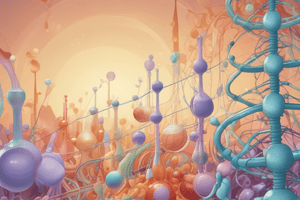Podcast
Questions and Answers
What does the Biuret test detect?
What does the Biuret test detect?
- Cysteine
- Amines
- Peptides with at least two peptide bonds (correct)
- Tyrosine
What color indicates a positive result in the Ninhydrin test?
What color indicates a positive result in the Ninhydrin test?
Purple solution
The presence of tyrosine is detected by the Millon’s test.
The presence of tyrosine is detected by the Millon’s test.
True (A)
What color indicates a positive result in the Xanthoproteic test?
What color indicates a positive result in the Xanthoproteic test?
What does the Hopkins-Cole test detect?
What does the Hopkins-Cole test detect?
Which test uses glyoxylic acid and sulfuric acid?
Which test uses glyoxylic acid and sulfuric acid?
In the Fohl’s test, a positive result is indicated by a ______ precipitate.
In the Fohl’s test, a positive result is indicated by a ______ precipitate.
What is detected by the Molisch test?
What is detected by the Molisch test?
What positive indication does the Iodine test provide?
What positive indication does the Iodine test provide?
Benedict's test detects sucrose directly.
Benedict's test detects sucrose directly.
Match the following tests with what they detect:
Match the following tests with what they detect:
What is the optimal pH for invertase activity?
What is the optimal pH for invertase activity?
The effect of temperature on invertase shows optimum activity at ______ degrees Celsius.
The effect of temperature on invertase shows optimum activity at ______ degrees Celsius.
Flashcards are hidden until you start studying
Study Notes
Qualitative Tests for Proteins
- Biuret Test: Detects the presence of peptide bonds in proteins.
- Reagent: Biuret reagent (blue) containing copper (II) sulfate, sodium hydroxide, and potassium sodium tartrate.
- Positive Result: Violet-colored complex, with the intensity of the color increasing with the number of peptide bonds.
- Ninhydrin Test: Detects the presence of free amino groups in proteins.
- Reagent: Ninhydrin solution (colorless).
- Positive Result: Purple solution.
- Exception: Hydroxyproline and proline produce a yellow solution.
- Millon’s Test: Detects the presence of tyrosine and phenolic functional groups.
- Reagent: Millon’s reagent (colorless) containing mercuric nitrate and mercurous nitrate dissolved in nitric acid and distilled water.
- Positive Result: Red or pink-colored precipitate.
- Xanthoproteic Test: Detects the presence of aromatic functional groups, such as those found in tyrosine and tryptophan.
- Reagent: Concentrated nitric acid and sodium hydroxide.
- Positive Result: Yellow or orange solution.
- Exception: Phenylalanine is negative, but it can become positive with extended heating.
- Hopkins-Cole Test: Detects the presence of tryptophan, which contains an indole group.
- Reagent: Glyoxylic acid and sulfuric acid.
- Positive Result: Purple ring.
- Fohl’s Test: Detects the presence of cysteine and cystine.
- Reagent: Sodium hydroxide and lead acetate.
- Positive Result: Black precipitate.
- Exception: Methionine is negative.
- Pauly’s Test: Detects the presence of tyrosine, histidine, amines, phenols, and imidazole groups.
- Reagent: Sulfanilic acid, HCl, sodium nitrite, and sodium carbonate.
- Positive Result: Red-colored complex.
- Sakaguchi Test: Detects the presence of arginine, which contains a guanidino group.
- Reagent: 1-naphthol and sodium hypobromite.
- Positive Result: Red-colored complex.
Qualitative Tests for Carbohydrates
- Molisch Test: Detects the presence of carbohydrates except tetroses and trioses.
- Reagent: Molisch reagent (α-naphthol) and sulfuric acid.
- Positive Result: Purple ring.
- Mechanism: Sulfuric acid forms furfural from pentoses and hydroxymethylfurfural from hexoses.
- Iodine Test: Detects the presence of starch (amylose).
- Positive Result: Blue-black solution.
- Benedict’s Test: Detects the presence of reducing sugars, which contain hemiacetal functional groups.
- Reagent: Benedict’s reagent (blue) containing copper (II) sulfate, sodium carbonate, and sodium citrate.
- Positive Result: Brick-red precipitate.
- Barfoed’s Test: Detects the presence of monosaccharides.
- Reagent: Barfoed’s reagent (blue) containing copper (II) acetate and acetic acid.
- Positive Result: Brick-red precipitate.
- Note: Disaccharides are also reducing sugars, but their reaction is slower.
- Fehling’s Test: Detects the presence of aldehydes, aldoses, and alpha-hydroxy-ketones.
- Reagent: Fehling’s reagent (A: copper (II) sulfate, B: potassium sodium tartrate and sodium hydroxide).
- Positive Result: Brick-red precipitate.
- Seliwanoff’s Test: Detects the presence of ketoses (ketones) - specifically fructose.
- Reagent: Resorcinol in concentrated HCl.
- Positive Result: Cherry red color.
- Mechanism: HCl causes the formation of furfural derivatives.
- Bial’s Test: Detects the presence of pentoses.
- Reagent: Orcinol, concentrated HCl, and FeCl3.
- Positive Result: Blue or green color.
- Mechanism: HCl causes the formation of furfural from pentoses.
Enzyme Activity of Invertase
- Invertase: Enzyme that breaks down sucrose into glucose and fructose.
- Monitoring: Benedict’s test can be used to monitor the reaction, as it detects fructose and glucose but not sucrose.
- Reducing Sugars: Fructose and glucose are reducing sugars, producing a brick-red precipitate in Benedict’s test.
- Effect of Concentration:
- Optimum Concentration: 10% sucrose.
- Above Optimum: No observable change in activity.
- Effect of Temperature:
- Optimum Temperature: Room temperature.
- Effect of pH:
- Optimum pH: pH 5.
- Above Optimum: Decreased activity.
HIMALA and MIRACLE
- HIMALA: A hypothetical substance that is positive for Sakaguchi, Fohl’s, and Pauly’s tests.
- MIRACLE: A hypothetical substance that is negative for Sakaguchi, Fohl’s, and Pauly’s tests.
Confirmed Present in Unknown Sample Based on Tests:
- Arginine
- Tryptophan
- Histidine
Studying That Suits You
Use AI to generate personalized quizzes and flashcards to suit your learning preferences.



